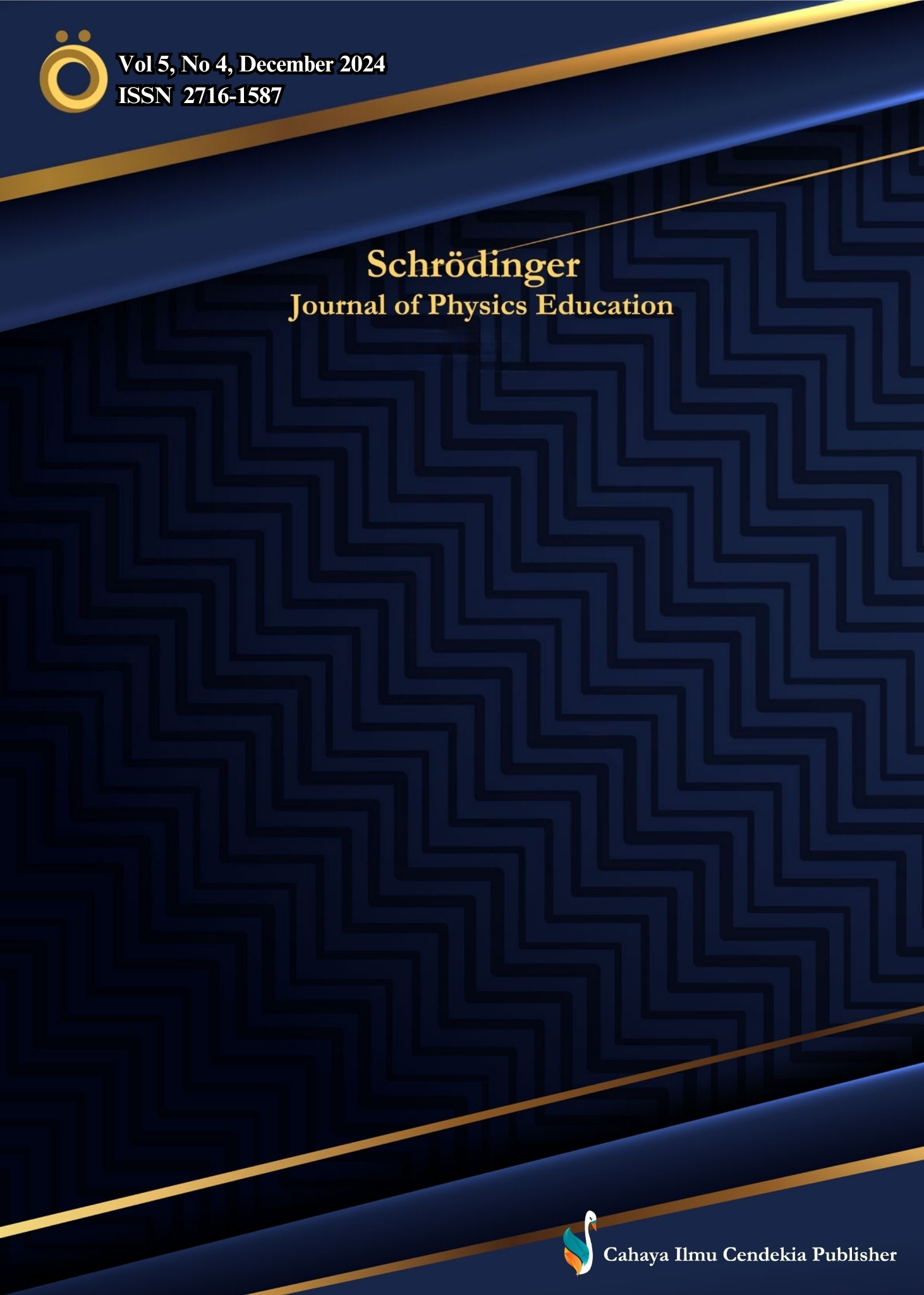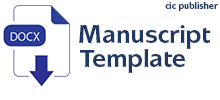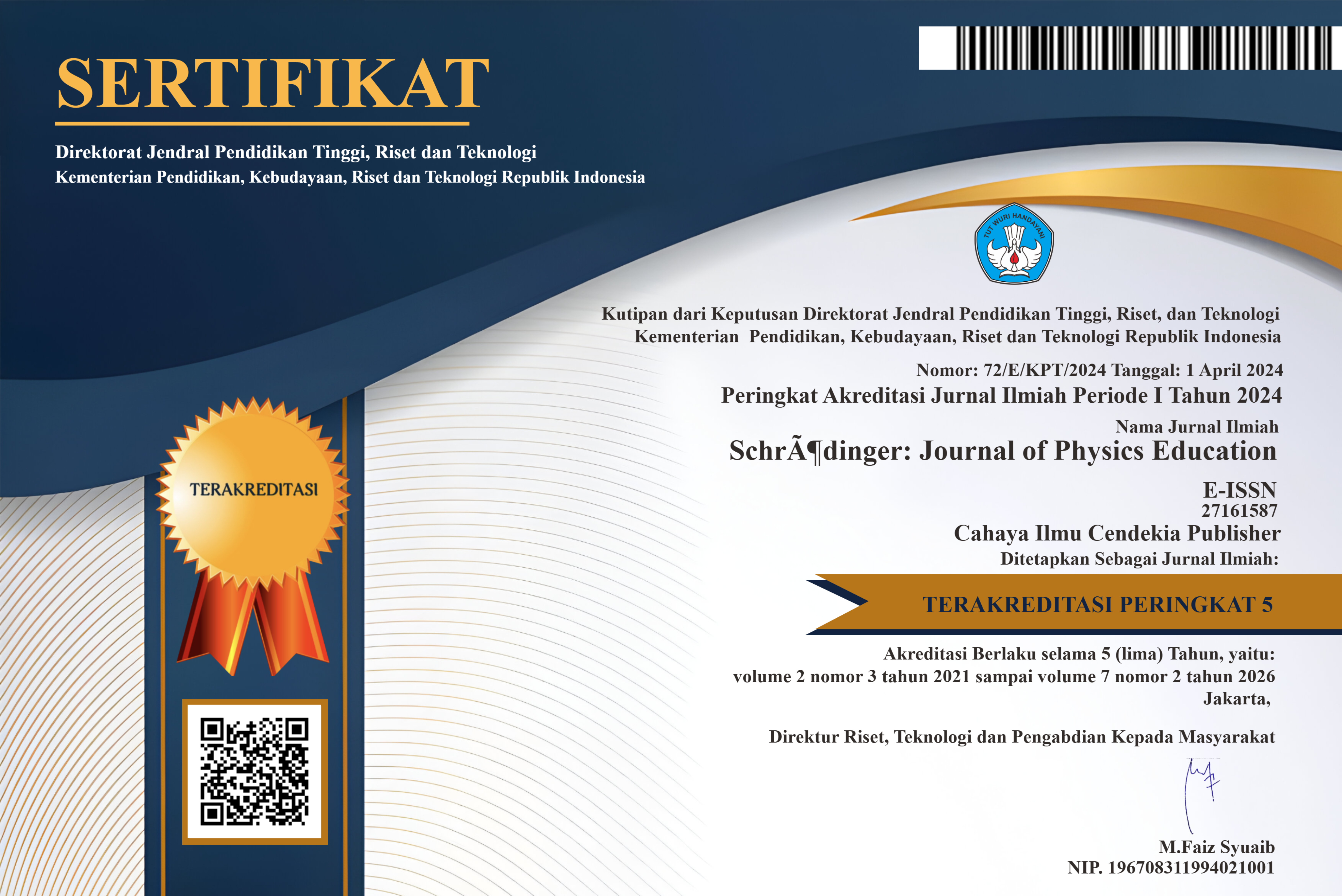Enhancing Classroom Engagement: Investigating Student Motivation towards Learning Physics
Abstract
Purpose of the study: The aim of this study is to identify effective intervention activities in the physics classroom that enhance student engagement and sustain attention toward learning physics by evaluating the impact of diverse strategies on student motivation.
Methodology: The study used Vevox (an engagement platform), group work, physics simulations, and educational videos. Data were collected through pre- and post-intervention surveys, student rankings, and performance evaluations, and analyzed using statistical software for quantitative insights.
Main Findings: Group work and physics simulations were found to be the most effective strategies for boosting student engagement and motivation. Students reported increased interest, enjoyment, and improved focus during physics lessons as a result of the interventions.
Novelty/Originality of this study: This study offers a novel approach by integrating diverse, data-driven intervention strategies to improve student motivation in physics classrooms, providing actionable insights for educators to create more engaging and effective learning environments.
References
R. Steinmayr, A. F. Weidinger, M. Schwinger, and B. Spinath, “The importance of students’ motivation for their academic achievement-replicating and extending previous findings,” Front Psychol, vol. 10, no. JULY, 2019, Doi: 10.3389/fpsyg.2019.01730.
M. London, V. I. Sessa, and L. A. Shelley, “Annual Review of Organizational Psychology and Organizational Behavior Developing Self-Awareness: Learning Processes for Self-and Interpersonal Growth,” 2022, Doi: 10.1146/annurev-orgpsych-120920.
S. Edgar, S. E. Carr, J. Connaughton, and A. Celenza, “Student motivation to learn: Is self-belief the key to transition and first year performance in an undergraduate health professions program?” BMC Med Educ, vol. 19, no. 1, Apr. 2019, Doi: 10.1186/s12909-019-1539-5.
D. M. McInerney, “Motivation,” Educational Psychology, vol. 39, no. 4. Routledge, pp. 427–429, Apr. 21, 2019. Doi: 10.1080/01443410.2019.1600774.
R. Holubova, “How to Motivate our Students to Study Physics?” Universal Journal of Educational Research, vol. 3, no. 10, pp. 727–734, Oct. 2015, Doi: 10.13189/ujer.2015.031011.
R. D. Manuel Guido, “Attitude and Motivation towards Learning Physics,” 2013. [Online]. Available: www.ijert.org
D. Kwarikunda, U. Schiefele, J. Ssenyonga, and C. M. Muwonge, “Secondary School Students’ Motivation Profiles for Physics Learning: Relations with Cognitive Learning Strategies, Gender, Attitudes and Individual Interest,” African Journal of Research in Mathematics, Science and Technology Education, vol. 25, no. 2, pp. 197–210, 2021, Doi: 10.1080/18117295.2021.1956720.
J. M. Changeiywo, P. W. Wambugu, and S. W. Wachanga, “Investigations Of Students’ Motivation Towards Learning Secondary School Physics Through Mastery Learning Approach.”
R. Holubova, “How to Motivate our Students to Study Physics?” Universal Journal of Educational Research, vol. 3, no. 10, pp. 727–734, Oct. 2015, Doi: 10.13189/ujer.2015.031011.
R. Steinmayr, A. F. Weidinger, M. Schwinger, and B. Spinath, “The importance of students’ motivation for their academic achievement-replicating and extending previous findings,” Front Psychol, vol. 10, no. JULY, 2019, Doi: 10.3389/fpsyg.2019.01730.
K. B. Capunitan, J. D. Lirado, and C. F. Gregana, “Motivational Factors in Science Learning, Learner’s Satisfaction and Learning Outcomes of Pre-Service Teachers,” International Journal of Scientific and Management Research, vol. 06, no. 05, pp. 72–115, 2023, Doi: 10.37502/ijsmr.2023.6504.
S. Edgar, S. E. Carr, J. Connaughton, and A. Celenza, “Student motivation to learn: Is self-belief the key to transition and first year performance in an undergraduate health professions program?” BMC Med Educ, vol. 19, no. 1, Apr. 2019, Doi: 10.1186/s12909-019-1539-5.
M. P. Silverman, “Motivating Students to Learn Science: A Physicist’s Perspective,” Creat Educ, vol. 06, no. 18, pp. 1892–1992, 2015, Doi: 10.4236/ce.2015.618203.
R. Setiawan, A. Aprillia, and N. Magdalena, “Analysis of antecedent factors in academic achievement and student retention,” Asian Association of Open Universities Journal, vol. 15, no. 1, pp. 37–47, Jul. 2020, Doi: 10.1108/AAOUJ-09-2019-0043.[15] A. Jafri, “An Examination Of Student’s Motivation To Learn In Higher Education: A Study Of Contributing Factors To Undergraduate Students” Ph.D dissertation, Education and Psychology Department, Pepperdine University, Malibu, California, 2023, https://digitalcommons.pepperdine.edu/etd
E. Yilmaz, M. Şahin, and M. Turgut, “Journal of Education and Practice www.iiste.org ISSN,” Online, 2017. [Online]. Available: www.iiste.org[17] M. Zeidan, X. Huang, L. Xiao, R. Holloway, and R. Zhao, Improving student engagement using video-enabled activity-based learning: an exploratory study of STEM preparatory education in the United Arab Emirates (UAE), Journal of Learning Development in Higher Education, Issue 24, 2022, DOI: https://doi.org/10.47408/jldhe.vi24.888.
H. J. Banda and J. Nzabahimana, “The Impact of Physics Education Technology (PhET) Interactive Simulation-Based Learning on Motivation and Academic Achievement Among Malawian Physics Students,” J Sci Educ Technol, vol. 32, no. 1, pp. 127–141, Feb. 2023, Doi: 10.1007/s10956-022-10010-3.
A. Khoudri, I. Khoudri, and A. Khoudri, “Examining the Influence of Gamification on the Enjoyment, Engagement, and Motivation of Secondary School Students: A Case Study of Vevox Examining the Influence of Gamification on the Enjoyment, Engagement, and Motivation of Secondary School Students: A Case Study of Vevox Article History,” International Journal of Current Educational Studies, vol. 2023, no. 2, pp. 1–15, 2023, Doi: 10.5281/zenodo.8422727.
J. Greenwood, “Journal of Learning Development in Higher Educations) (CC-BY 4.0) Ready player one: using Vevox to elicit student participation in lectures.”
A. L. Stephens and J. J. Clement, “Use of physics simulations in whole class and small group settings: Comparative case studies,” Comput Educ, vol. 86, pp. 137–156, Aug. 2015, Doi: 10.1016/j.compedu.2015.02.014.
P. Zhang, L. Ding, and E. Mazur, “Peer Instruction in introductory physics: A method to bring about positive changes in students’ attitudes and beliefs,” Phys Rev Phys Educ Res, vol. 13, no. 1, 2017, Doi: 10.1103/PhysRevPhysEducRes.113.010104.
T. Greczyło, “Video clips in physics education,” in Journal of Physics: Conference Series, Institute of Physics, 2024. Doi: 10.1088/1742-6596/2727/1/012024.
O. Ketsman, T. Daher, and J. A. Colon Santana, “An investigation of effects of instructional videos in an undergraduate physics course,” E-Learning and Digital Media, vol. 15, no. 6, pp. 267–289, Nov. 2018, Doi: 10.1177/2042753018805594.
J. Lee and N. Didiş Körhasan, “Effect of group type on group performance in peer-collaborated two-round physics problem solving,” Phys Rev Phys Educ Res, vol. 18, no. 2, Jul. 2022, Doi: 10.1103/PhysRevPhysEducRes.18.020112.
T. J. Price, “Real-time polling to help corral university-learners’ wandering minds,” Journal of Research in Innovative Teaching & Learning, vol. 15, no. 1, pp. 98–109, Apr. 2022, Doi: 10.1108/jrit-03-2020-0017.
H. J. Banda and J. Nzabahimana, “Effect of integrating physics education technology simulations on students’ conceptual understanding in physics: A review of literature,” Phys. Rev. Phys. Educ. Res., vol. 17, no. 2, p. 23108, 2021, doi: 10.1103/PhysRevPhysEducRes.17.023108.
H. J. Banda and J. Nzabahimana, “The Impact of Physics Education Technology (PhET) Interactive Simulation-Based Learning on Motivation and Academic Achievement Among Malawian Physics Students,” J. Sci. Educ. Technol., vol. 32, no. 1, pp. 127–141, 2023, doi: 10.1007/s10956-022-10010-3.
T. Makkonen, K. Tirri, and J. Lavonen, “Engagement in Learning Physics Through Project-Based Learning: A Case Study of Gifted Finnish Upper-Secondary-Level Students,” J. Adv. Acad., vol. 32, no. 4, pp. 501–532, 2021, doi: 10.1177/1932202X211018644.
M. A. M. AlGerafi, Y. Zhou, M. Oubibi, and T. T. Wijaya, “Unlocking the Potential: A Comprehensive Evaluation of Augmented Reality and Virtual Reality in Education,” Electron., vol. 12, no. 18, 2023, doi: 10.3390/electronics12183953.
R. Rianti, G. Gunawan, N. N. S. P. Verawati, and M. Taufik, “The Effect of Problem Based Learning Model Assisted by PhET Simulation on Understanding Physics Concepts,” Lensa J. Kependidikan Fis., vol. 12, no. 1, p. 28, 2024, doi: 10.33394/j-lkf.v12i1.8783.
F. Molin, C. Haelermans, S. Cabus, and W. Groot, “Do feedback strategies improve students’ learning gain?-Results of a randomized experiment using polling technology in physics classrooms,” Comput. Educ., vol. 175, no. July, p. 104339, 2021, doi: 10.1016/j.compedu.2021.104339.
Copyright (c) 2024 Mohammad Zeidan, David Young

This work is licensed under a Creative Commons Attribution 4.0 International License.
Authors who publish with this journal agree to the following terms:
- Authors retain copyright and acknowledge that the Schrödinger: Journal of Physics Education is the first publisher licensed under a Creative Commons Attribution 4.0 International License.
- Authors are able to enter into separate, additional contractual arrangements for the non-exclusive distribution of the journal's published version of the work (e.g., post it to an institutional repository or publish it in a book), with an acknowledgment of its initial publication in this journal.
- Authors are permitted and encouraged to post their work online (e.g., in institutional repositories or on their website) prior to and during the submission process, as it can lead to productive exchanges and earlier and greater citation of published work.







.png)
.png)








.png)
.png)
.png)







